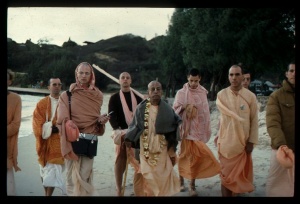CC Antya 2.34-35: Difference between revisions
m (1 revision(s)) |
No edit summary |
||
| Line 1: | Line 1: | ||
{{ | [[Category:Sri Caitanya-caritamrta - Antya-lila Chapter 02|C034]] | ||
<div style="float:left">'''[[Sri Caitanya-caritamrta|Śrī Caitanya-caritāmṛta]] - [[CC Antya|Antya-līlā]] - [[CC Antya 2|Chapter 2: The Chastisement of Junior Haridāsa]]'''</div> | |||
<div style="float:right">[[File:Go-previous.png|link=CC Antya 2.33|Antya-līlā 2.33]] '''[[CC Antya 2.33|Antya-līlā 2.33]] - [[CC Antya 2.36|Antya-līlā 2.36]]''' [[File:Go-next.png|link=CC Antya 2.36|Antya-līlā 2.36]]</div> | |||
{{CompareVersions|CC|Antya 2.34-35|CC 1975|CC 1996}} | |||
{{RandomImage}} | |||
==== TEXTS 34-35 ==== | ==== TEXTS 34-35 ==== | ||
<div class="verse"> | |||
<div | :śacīra mandire, āra nityānanda-nartane | ||
śacīra mandire, āra nityānanda-nartane | :śrīvāsa-kīrtane, āra rāghava-bhavane | ||
śrīvāsa-kīrtane, āra rāghava-bhavane | :ei cāri ṭhāñi prabhura sadā ‘āvirbhāva’ | ||
ei cāri ṭhāñi prabhura sadā ‘āvirbhāva’ | :premākṛṣṭa haya,—prabhura sahaja svabhāva | ||
premākṛṣṭa haya,—prabhura sahaja svabhāva | |||
</div> | </div> | ||
| Line 15: | Line 18: | ||
==== SYNONYMS ==== | ==== SYNONYMS ==== | ||
<div class="synonyms"> | |||
<div | ''śacīra mandire''—in the household temple of mother Śacī; ''āra''—and; ''nityānanda-nartane''—at the time of Śrī Nityānanda Prabhu’s dancing; ''śrīvāsa-kīrtane''—at the time of congregational chanting headed by Śrīvāsa Paṇḍita; ''āra''—and; ''rāghava-bhavane''—in the house of Rāghava; ''ei cāri ṭhāñi''—in these four places; ''prabhura''—of Śrī Caitanya Mahāprabhu; ''sadā''—always; ''āvirbhāva''—appearance; ''prema-ākṛṣṭa haya''—is attracted by love; ''prabhura''—of Śrī Caitanya Mahāprabhu; ''sahaja svabhāva''—natural characteristic. | ||
śacīra | |||
</div> | </div> | ||
| Line 23: | Line 25: | ||
==== TRANSLATION ==== | ==== TRANSLATION ==== | ||
<div class="translation"> | |||
<div | |||
Śrī Caitanya Mahāprabhu always appeared in four places—in the household temple of mother Śacī, in the places where Śrī Nityānanda Prabhu danced, in the house of Śrīvāsa Paṇḍita during congregational chanting, and in the house of Rāghava Paṇḍita. He appeared because of His attraction to the love of His devotees. That is His natural characteristic. | Śrī Caitanya Mahāprabhu always appeared in four places—in the household temple of mother Śacī, in the places where Śrī Nityānanda Prabhu danced, in the house of Śrīvāsa Paṇḍita during congregational chanting, and in the house of Rāghava Paṇḍita. He appeared because of His attraction to the love of His devotees. That is His natural characteristic. | ||
</div> | </div> | ||
__NOTOC__ | |||
<div style="float:right; clear:both;">[[File:Go-previous.png|link=CC Antya 2.33|Antya-līlā 2.33]] '''[[CC Antya 2.33|Antya-līlā 2.33]] - [[CC Antya 2.36|Antya-līlā 2.36]]''' [[File:Go-next.png|link=CC Antya 2.36|Antya-līlā 2.36]]</div> | |||
__NOTOC__ | |||
__NOEDITSECTION__ | |||
Revision as of 10:39, 20 September 2021

A.C. Bhaktivedanta Swami Prabhupada
TEXTS 34-35
- śacīra mandire, āra nityānanda-nartane
- śrīvāsa-kīrtane, āra rāghava-bhavane
- ei cāri ṭhāñi prabhura sadā ‘āvirbhāva’
- premākṛṣṭa haya,—prabhura sahaja svabhāva
SYNONYMS
śacīra mandire—in the household temple of mother Śacī; āra—and; nityānanda-nartane—at the time of Śrī Nityānanda Prabhu’s dancing; śrīvāsa-kīrtane—at the time of congregational chanting headed by Śrīvāsa Paṇḍita; āra—and; rāghava-bhavane—in the house of Rāghava; ei cāri ṭhāñi—in these four places; prabhura—of Śrī Caitanya Mahāprabhu; sadā—always; āvirbhāva—appearance; prema-ākṛṣṭa haya—is attracted by love; prabhura—of Śrī Caitanya Mahāprabhu; sahaja svabhāva—natural characteristic.
TRANSLATION
Śrī Caitanya Mahāprabhu always appeared in four places—in the household temple of mother Śacī, in the places where Śrī Nityānanda Prabhu danced, in the house of Śrīvāsa Paṇḍita during congregational chanting, and in the house of Rāghava Paṇḍita. He appeared because of His attraction to the love of His devotees. That is His natural characteristic.